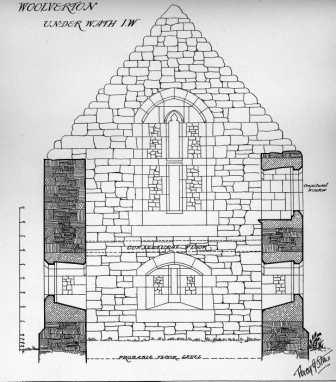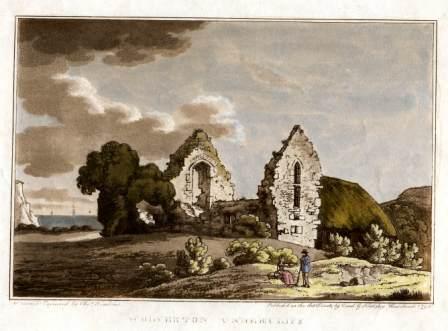
WOLVERTON, though situated just under the old Church of S. Lawrence, lies really in Whitwell parish, which here reaches the south coast of the Island. All that we can identify of the ruins clearly point to the former existence of a domestic building of the early part of the I4th century, built by one of the family of De Wolverton,a who owned, on the mainland near Highclere, property which still retains the family name, as well as land in the Isle of Wight lying in Shorwell parish. Some writers have asserted this ancient house to be a thirteenth century building, but a close examination will disprove this assertion, as well as the still more erroneous one of its having been a chapel. The long gable lights in the upper story have cusped heads, with a decided ogival curve in the upper cusp, and transoms * about half-way down. With regard to the second assertion, what would have been the use of a distinct chapel within a stone's-throw of an existing church, which the few tenants b De Wolverton may have had could easily have attended ? Besides, it faces north and south, and there is no appearance even of there having been a vaulted undercroft, as was the usual custom in buildings used for the celebration of divine service.c We may take it to have formed one of the mediaeval domestic residences, of which two only besides Wolverton remain—those of Swainston and Chale, both exhibiting same characteristics : a great hall or living room, lighted by a traceried gable window, a store or kitchen underneath, and a lower annexe adjoining one end, the upper story which was used as a bed or retiring room for the lord, while the basement formed the servants' quarters.
At Wolverton this annexe was of one story only, and indeed it is difficult to believe building itself was ever used for a dwelling-house. The window openings, even on the floor, are mere slits six inches wide, a necessary precaution perhaps in so wind-swept situation ; but then, the gloom of it!—no knight's dame, I feel sure, would have stood a such a state of things. My own opinion is that it was merely built as a refuge or store, erected, may be, for the steward's use, who would be appointed to look after his lord's :shore-rights and receive the rents of the farmlands. d There seem to be no traces of adjoining buildings of a later date, as in the other instances of Chale and Swainston ;besides, in such a situation, winter residence would have been well-nigh an impossibility to anyone possessed of the crudest ideas of comfort.
Tomkins has a print, dated 1796, showing both gables with transomed single lights, and the low annexe to the south-east much as it now stands, while a small thatched building, apparently a shed, abuts against the west wall of the main building.
* I do not put this latter assertion forward as a refutation of the 13th century theory, as transoms do occur in windows of this period, teste King's Hall, Winchester, 1222-35 ; Carisbrooke Castle ; Stokesay Castle, Salop, &c.
.
Notes
a.. Wolverton in Whitwell, and Wolverton in Shorwell, were both held under the same lords, i.e. the Esturs or de Insulas of Gatcombe. The adjoining lands, formerly in the same ownership, are still called the " Old Park."
b. De Wolverton held little land apparently about here, the families of De Aula and Russell holding the adjacent manors of Span and St. Lawrence.
c. Mr. W. T. Stratton, of Newport, speaking of circa 1850, tells me he remembers the socket-holes in which the floor beams rested. The ivy, unfortunately, is so thick now that I cannot verify this statement, but Mr. Stratton is too well-known as a careful observer to have any doubt cast upon his assertion.
d. It has been suggested that it may have formed a hunting-lodge for the use of the branch of the De Wolverton family residing at Shorwell. The property then owned by them on the southern coast comprised all the Undercliff between the parishes of St. Lawrence and Niton Niton, it was was a long way thence to Shorwell, and the state of the roads, if any really existed, can be conjectured.
From Percy Stone. Architectural History of the Isle of Wight. 1891 Checklist no. 1214.



From Tomkins, C. A Tour in the Isle of Wight in 1793. 1795. Checklist no. 244